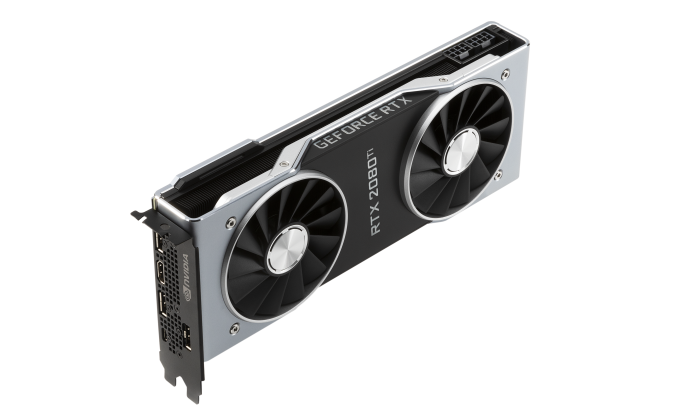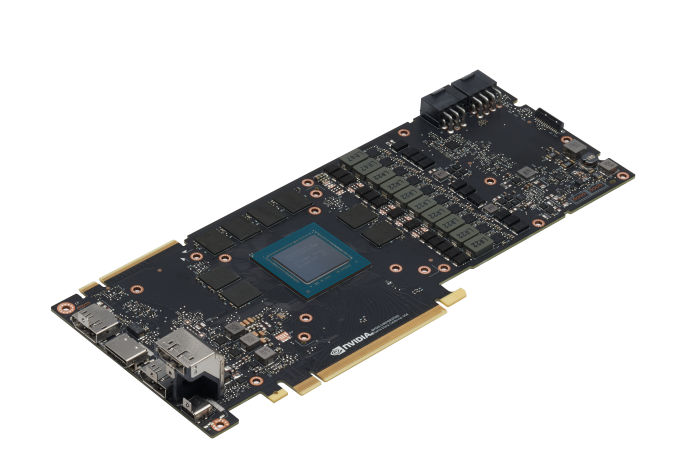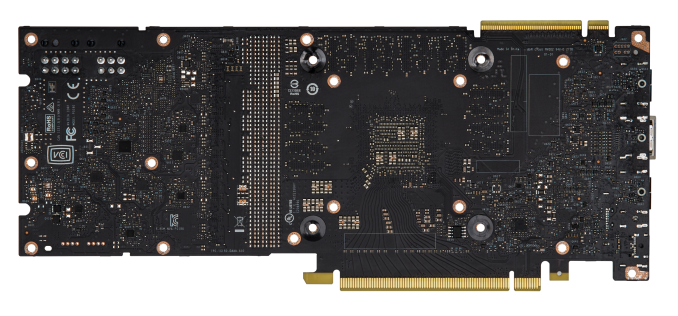The NVIDIA GeForce RTX 2080 Ti & RTX 2080 Founders Edition Review: Foundations For A Ray Traced Future
by Nate Oh on September 19, 2018 5:15 PM EST- Posted in
- GPUs
- Raytrace
- GeForce
- NVIDIA
- DirectX Raytracing
- Turing
- GeForce RTX
Meet The GeForce RTX 2080 Ti & RTX 2080 Founders Editions Cards
Moving onto the design of the cards, we've already mentioned the biggest change: a new open air cooler design. Along with the Founders Edition specification changes, the cards might be considered 'reference' in that they remain a first-party video card sold direct by NVIDIA, but strictly-speaking they are not because they no longer carry reference specifications.
Otherwise, NVIDIA's industrial design language prevails, and the RTX cards bring a sleek flattened aesthetic over the polygonal shroud of the 10 series. The silver shroud now encapsulates an integrated backplate, and in keeping with the presentation, the NVLink SLI connectors have a removable cover.
Internally, the dual 13-blade fans accompany a full-length vapor chamber and component baseplate, connected to a dual-slot aluminum finstack. Looking at improving efficiency and granular power control, the 260W RTX 2080 Ti Founders Edition features a 13-phase iMON DrMOS power subsystem with a dedicated 3-phase system for the 14 Gbps GDDR6, while the 225W RTX 2080 Founders Edition weighing in with 8-phases main and 2-phases memory.
As is typical with higher quality designs, NVIDIA is pushing overclocking, and for one that means a dual 8-pin PCIe power configuration for the 2080 Ti; on paper, this puts the maximum draw at 375W, though specifications-wise the TDP of the 2080 Ti Founders Edition against the 1080 Ti Founders Edition is only 10W higher. The RTX 2080 Founders Edition has the more drastic jump, however, with 8+6 pins and a 45W increase over the 1080's lone 8 pin and 180W TDP. Ultimately, it's a steady increase from the power-sipping GTX 980's 165W.
One of the more understated changes comes with the display outputs, which thanks to Turing's new display controller now features DisplayPort 1.4 and DSC support, the latter of which is part of the DP1.4 spec. The eye-catching addition is the VR-centric USB-C VirtualLink port, which also carries an associated 30W not included in the overall TDP.
Something to note is that this change in reference design, combined with the seemingly inherent low-volume nature of the Turing GPUs, cuts into an often overlooked but highly important aspect of GPU sales: big OEMs in the desktop and mobile space. Boutique system integrators will happily incorporate the pricier higher-end parts but from the OEM’s perspective, the GeForce RTX cards are not just priced into a new range beyond existing ones but also bringing higher TDPs and no longer equipped with blower-style coolers in its ‘reference’ implementation.
Given that OEMs often rely on the video card being fully self-exhausting because of a blower, it would certainly preclude a lot of drop-in replacements or upgrades – at least not without further testing. It would be hard to slot into the standard OEM product cycle at the necessary prices, not to mention the added difficulty in marketing. In that respect, there is definitely more to the GeForce RTX 20 series story, and it’s somewhat hard to see OEMs offering GeForce RTX cards. Or even the RT Cores themselves existing below the RTX 2070, just on basis of the raw performance needed for real time ray tracing effects at reasonable resolutions and playable framerates. So it will be very interesting to see how the rest of NVIDIA’s product stack unfolds.
















337 Comments
View All Comments
Holliday75 - Friday, September 21, 2018 - link
Good thing there are cops around to keep me honest. If they weren't I'd go on a murder spree and blame them for it.Yojimbo - Wednesday, September 19, 2018 - link
It's NVIDIA making a conscious decision to spend its engineering resources on innovating and implementing new technologies that will shift the future of gaming instead of spending that energy and die space on increasing performance as much as it can in today's titles. If NVIDIA left out the RT cores and other new technologies they could have easily increased performance 50 or 60% in legacy technologies by building chips bigger than Pascal but smaller than Turing, while increasing prices only moderately. Then everyone would be happy getting a card that would be leading them into a gaming torpor. In a few years when everyone is capable of running at 4k and over 60 fps they'd get bored and wonder why the industry were going nowhere.NikosD - Wednesday, September 19, 2018 - link
nVidia has done the same thing in the past, introducing new technologies and platforms like tesselation, PhysX, HairWorks, GameWorks, GPP etc.All of these were proved to be just tricks in order to kill competition, like always, which nowadays means to kill AMD.
Pseudoraytracing is not an innovation or something mandatory for gaming.
It's just another premature technology that the opponent doesn't have in order to be nVidia unique again with huge cost for the consumer and performance regression.
I repeat.
Skip that Turing fraud.
maximumGPU - Thursday, September 20, 2018 - link
i don't think it's fair to compare ray tracing to HairWorks...ray tracing is a superior way to render graphics compared to rasterisation, there's no question about this.
Lolimaster - Saturday, September 22, 2018 - link
But with what, nvidia RTX only do it on a small part of a FRAME, on selected scenes. On tensor core repurposed for that.You will need tensor cores in the 100's to make nvidia implementation more "wowish", 1000's to actually talk about raytracing being a thing.
Consoles dictate gaming progress, AMD holds that.
Lolimaster - Saturday, September 22, 2018 - link
Exactly, to start talking about actual raytracing or at least most of the parts of a scene, we need 10-100x the current gpu performance.Yojimbo - Saturday, September 22, 2018 - link
GPP was a partner promotion program. Hairworks is part of Gameworks. PhysX is part of Gameworks. Gameworks is not a trick, and neither is the PhysX part of it. But neither of them compare to ray tracing. Maybe you should like up what the word "pseudo" means, because you're using it wrong.In 1 year or a year and a half AMD will have their own ray tracing acceleration hardware and then you'll be all in on it.
As for killing AMD, NVIDIA are not interested in it. It wouldn't be good for them, anyway. NVIDIA are, however, interested in building their platform and market dominance.
Yojimbo - Saturday, September 22, 2018 - link
Edit: look up*Eris_Floralia - Thursday, September 20, 2018 - link
I've read all ur comments and still struggle to find any consistent logic.eva02langley - Thursday, September 20, 2018 - link
Nvidia is throwing down the throat of gamers Ray Tracing development. We are paying for something that we didn't even wanted at first.You didn't even know about Ray Tracing and DLSS before it was announced. You are just drinking the coolaid unlike many of us who stand out and raging against these INDECENT prices.